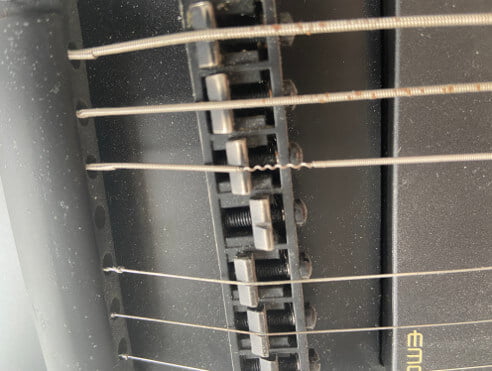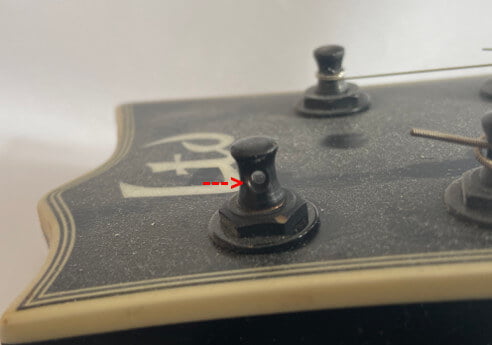Table of Contents
Breaking guitar strings can be an emotional experience! Especially if it happens at the worst possible time, which is normally tuning before a gig. There are many reasons why your guitar strings are breaking, most of which can be prevented.
In this Killer Rig article, we are going to look at the most common points of failure. And what you can do to prevent snapping strings as often as you might currently be experiencing.
Finding the Break Point
The first step in solving the issue of frequent breakage is to identify where the string tends to break. The location can offer valuable clues about the underlying problem.
Below you will find some of the more common break points and the potential causes.
At the Bridge

If you notice that your strings consistently break near the bridge, this could be a sign that the bridge has sharp edges or burrs.
The bridge is a high-tension area, and any imperfections can put extra stress on the strings, leading to breakage.
Near the Frets
Strings that break near the frets may be encountering rough or burred edges on the frets themselves. This is particularly likely if you find that different strings break but always near the same fret.
At the Nut
If the breakage occurs near the nut, it could be due to dirt accumulation or wear and tear. The nut is another high-tension area, and any friction or obstruction can lead to string failure.
The Tuning Posts

Strings that break near the tuning posts could be a result of the posts themselves. Sometimes, the posts can have burred edges or imperfections that cause the string to weaken and eventually break.
By carefully observing where your strings tend to break, you can pinpoint the likely cause and take appropriate corrective measures. This diagnostic approach is crucial for effective problem-solving and can save you both time and money in the long run.
Common Reasons for String Breakage
Understanding the root causes of string breakage is essential for effective prevention. Here are some of the most frequent reasons your guitar strings might be giving up the ghost:
Old Guitar Strings
Once your guitar strings become old, they will lose their elasticity. This is due to the metal work hardening over time. The outer wrap wire will also start to unravel and come undone. As a result, the string becomes unbalanced and more fragile.
They have also been tuned several times, rubbing against the tuners, nut, and bridge. This friction will eventually begin to wear the metal at the point of contact. It will then snap once it can’t handle any more wear.
You can tell when your strings are getting old because they will sound dull. They might also start to change color. The first sign of this is usually a slight darkening near the bridge. This is corrosion and will eventually destroy them.
This is all normal when it comes to electric and acoustic guitar strings. Over time, they naturally wear, begin to sound bad and might even smell or change colors.
Wrong Guitar Pick
While most players just assume the guitar pick is harmless to the strings, this is not true. Every time you strike the strings with a plectrum, it creates wear and stress on them.
Choosing the right guitar pick for the string gauge you use is quite important. A big, thick guitar pick slammed into extra light strings will only reduce its lifespan. The material is also important, as a metal plectrum will wear out your strings faster than any other.
Verified that your guitar parts are in good shape. If they are not causing your premature string failure, explore your pick type. If you are using a rigid material, try something softer and see if it helps.
Maybe it’s too thick and causing you to snap strings as often as you do. Try something lighter and see if it makes a difference.
Technique Is Too Aggressive
Sometimes as guitarists, we get very passionate about our music. This is especially true when playing gigs or in front of an audience. We may not notice it, but our playing becomes more aggressive and can add too much stress to the strings.
If you find that you are breaking strings, but the guitar is in perfect shape, you might want to look at how you play. If the string gauge is pretty light, they might not be able to take the extra abuse.
Adjust how you play and try and work out your strumming technique. If you realize that you might be a bit heavy-handed, try and play lighter at least while practicing.
You could also consider using bigger strings that can take more abuse. If you don’t bend a lot, then this might be the perfect fit for your tone and the string performance.
Frequent Tuning Changes
Guitar players use many tuning arrangements for different songs. This can add some great variation to your tones and can be a lot of fun. But this can also lead to string damage if you are using one guitar for all of them.
As you tighten and loosen your guitar strings many times, this will begin to fatigue them. The tension changes, wear from the nut, bridge seats and tuning posts all lead to string breakage.
If you have ever bent a piece of metal back and forth, you know that it will eventually break. Your guitar strings are under this kind of stress when the tuning changes frequently.
Get another guitar and try and use more of them for different tuning variations. This can be a great way to reduce the added stress of tuning changes. Even having 2 guitars that can be tuned to variations that are not too far from one another can help.
This can also help should you break a string on stage, an extra guitar can be a show saver!
Wrong String Gauge
Your choice of string gauge will make a difference. A light gauge can work for a heavy play style, but they might not last long. Lighter strings are strong, it’s true, but they are a better choice for lead players, guitarist who have a light touch.
If you are playing a form of metal that requires striking the strings quite hard, a light gauge might break sooner. If this is your experience, then you may want to consider a heavier string set.
Thicker strings are able to take more of a beating. Plus, they have a deeper sound that might even benefit your music style better. So consider your string thickness, it might just be that it’s the wrong fit for your style.
Preventive Measures
Taking proactive steps to prevent string breakage can save you both time and frustration. Here are some preventive measures you can implement to keep your strings intact for longer periods:
- Smoothing the Bridge: If your strings are breaking at the bridge, consider smoothing out the edges with a small file or sandpaper. This reduces the tension and friction on the strings, making them less likely to break.
- Fret Maintenance: For strings breaking near the frets, a bit of sandpaper can go a long way. Smooth out any rough or burred edges on the frets to eliminate points of weakness on your strings.
- Nut Cleaning and Lubrication: Regularly clean the nut slots to remove dirt and grime. You can also use a lubricant specifically designed for guitar nuts to reduce friction and improve tuning stability.
- Tuning Post Inspection: Check your tuning posts for any burred or sharp edges. If you find any, you can use an old wound string to smooth out the edges in a circular motion.
- Choosing the Right Strings: Always use strings that are appropriate for your guitar and your style of playing. If you use alternate tunings, consider custom string sets that maintain even tension across all strings.
- Regular Inspection: Make it a habit to regularly inspect your guitar for any signs of wear and tear or mechanical issues. Early detection can prevent string breakage and other problems.
- Professional Setup: If you’re experiencing frequent string breakage despite taking these preventive measures, it may be time to consult a professional for a complete guitar setup. This can identify and fix any underlying issues that may be causing the strings to break.
- Tuning Carefully: Avoid over-tightening the strings during tuning. Use a tuner to ensure you’re hitting the right notes without putting excessive tension on the strings.
- Climate Control: Extreme changes in temperature and humidity can affect your guitar and its strings. Store your guitar in a stable environment to minimize these effects.
Conclusion
Guitar strings are an important part of the instrument. They need to be taken care of, if you find that they are becoming discolored, change them. Be sure to inspect all the parts of your guitar and make sure they are in good condition to help them last longer.
If you find that your guitar is in good shape, you may also want to try using coated strings. They repel oils from your hands, and the coating may reduce friction when seated.
Check how you play and the techniques you use, as this can lead to string breakage as well.
Finally, when changing tunings, try and use more than one guitar if possible. At least to reduce the stress on the strings. By following these simple tips, you can help reduce string breakage. And enjoy your playing without downtime!
FAQs
Which guitar string is most likely to break?
If the conditions are not right, you will find that the first string, or your thinnest one, will be the one to break. This is because it’s thin and not wrapped with nickel.
In a lot of cases, it’s also the only string that gets overtightened, which will cause it to break even when brand new. There are a lot of players who complain that their 3rd or G-string tends to break more than they would like.
This can oftentimes be fixed by adding a few more wraps around the machine head shafts.
Why does my low E string keep breaking?
The low E string is the thickest one and takes the most abuse. It also experiences high tension, which can lead to breakage if the guitar is in poor condition.
There are a few things you can do to help extend the life of your low E string. First, make sure that your guitar is in good shape and the nut and saddle are not causing any excessive friction. Depending on where it breaks, inspect the area for sharp spots
Second, be mindful of your playing style and try not to be too aggressive. A heavier string gauge can also help with this, as they can take more abuse.

